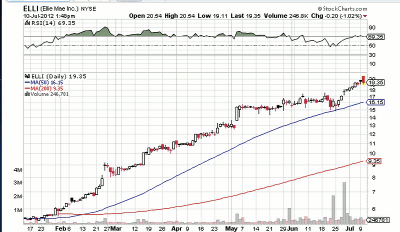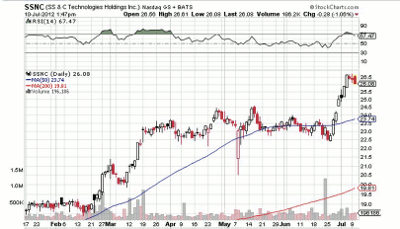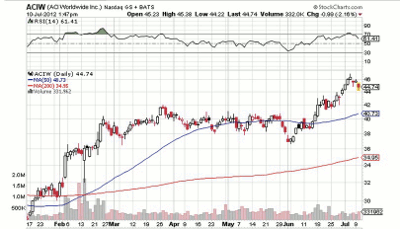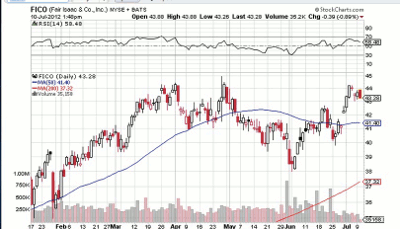Financial software is a sub-sector of tech that’s home to several small-cap stocks with good earnings growth and solid charts. Here’s a view of some of these names, and how they are situated relative to short-term moving averages, writes MoneyShow’s Kate Stalter.
Among sub-sectors of tech, there’s been some recent strength in financial software for specialized enterprise use.
One name I’ve written about previously is Ellie Mae (ELLI), maker of mortgage-origination software. Its clients are brokers and other professionals in the real-estate field.
The stock went public in April 2011 at $6. At mid-session Tuesday, it was trading at around $19.41, a gain of 224% since its debut. It rallied to an all-time high of $20.54 on Tuesday, but retreated amid general market malaise.
Ellie Mae is expected to report its second quarter sometime around August 2. Analysts have pegged earnings at 12 cents per share, up from two cents a year ago. Revenue is expected to come in at $19.84 million, a gain over $11.5 million in the year-ago quarter.
The stock is currently out of buy range, having trended above its five-day exponential moving average since June 26. If Tuesday’s pullback results in a retreat to the 15-day line before a fresh rebound begins, it may offer a new technical entry point.
Ellie Mae is a very small company, with a market cap of $493 million. It trades about 360,000 shares per day on average, on the thin side.
Another small-cap financial software maker with a good chart is SS&C Technologies (SSNC). The Connecticut-based company provides investment management software for hedge funds, pension funds, real estate investors, and commercial lenders, among others.
The stock has been gradually pulling back toward its five-day average, holding about 0.6% above that key price line. This could potentially offer an entry point below Monday’s high of $26.76.
This company has a market cap a bit north of $2 billion. But it’s not particularly liquid, moving about 195,000 shares per day on average.
SS&C is expected to report its second quarter on or around August 6. It’s seen earning 31 cents per share on revenue of $116.31 million. That would represent top- and bottom-line gains.
Another stock pulling back recently from previous highs is ACI Worldwide (ACIW), which makes point-of-sale and Internet billing software.
The stock rallied to a multi-year high of $46.90 on July 5. As you might expect in a holiday week, the move came on lower-than-average turnover.
The stock was down 2.4% Tuesday, to $44.64 on heavier volume. Janney Montgomery Scott downgraded the stock to Neutral from Buy. It’s not unusual for downgrade-driven retreats to be short-lived, with stocks rebounding fairly soon after the decline.
The stock was getting support above its 15-day exponential average Tuesday, potentially setting up for a buy opportunity.
However, market conditions would play a role in whether this stock—or many others—would be buyable any time soon. The general market confirmed a new uptrend on June 29, and continued to show gains during the holiday-abbreviated week that ended on July 6. This week, though, with more traders back at work, stocks are faltering.
I was reluctant to enter new positions last week, due to weak holiday volume. I was waiting to see if the market would continue its rally this week. So far, the jury is still out.
Perhaps because of renewed market weakness, many stocks that appeared on the verge of breakouts are continuing to consolidate. One well-known—but not necessarily well-loved—name from financial services is Fair Isaac (FICO). The keeper of the FICO scores could be forming a cup-and-handle chart pattern.
The stock is hovering below a multi-year high of $45, reached on April 26, the same day the general market went into a “head fake” rally before receding again.
A potential buy point in Fair Isaac could occur above $44.24, intermediate resistance from July 5. The stock is currently hovering just above its five-day exponential average, but there’s no upside momentum yet to indicate that it is ready for a new move higher.
Although Fair Isaac is a well-known company—at least among people who check their credit scores—this is also a small cap. The company’s market value is just shy of $1.5 billion. The stock trades around 274,000 shares per day, a bit on the thin side. It has a beta of 1.5, indicating greater volatility than the benchmark index.
Fair Isaac is expected to report its third quarter sometime around August 1, with analysts eyeing income of 59 cents a share on revenue of $158.53 million. Those would mark year-over-year gains.
At the time of publication, Kate Stalter did not own positions in any of the stocks mentioned in this column.
Related Reading:























